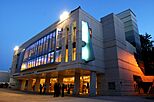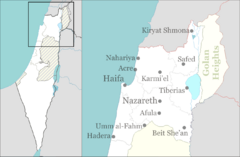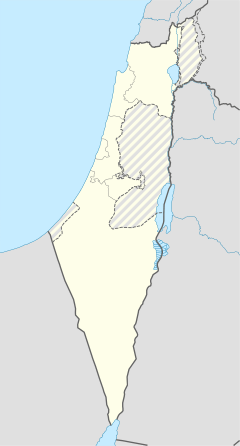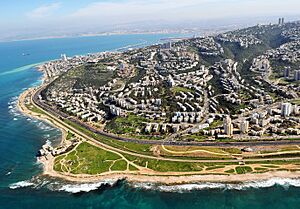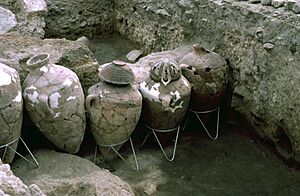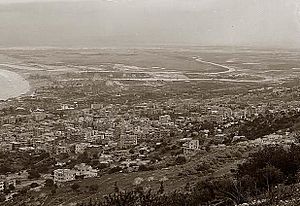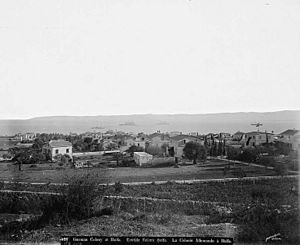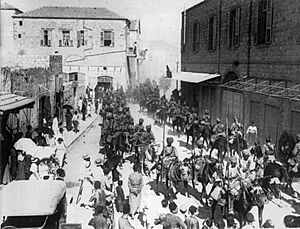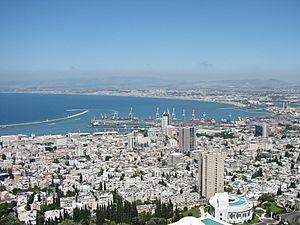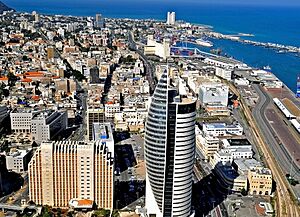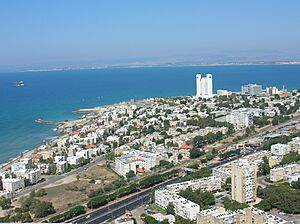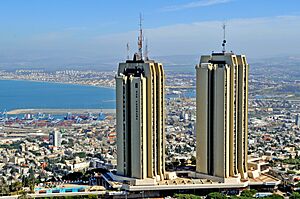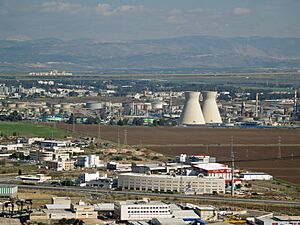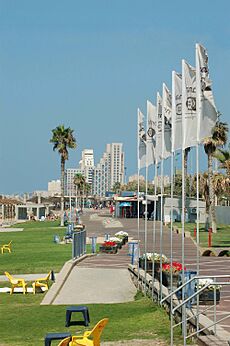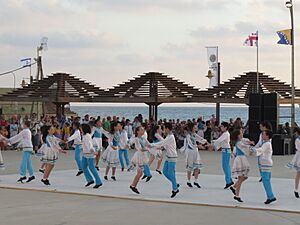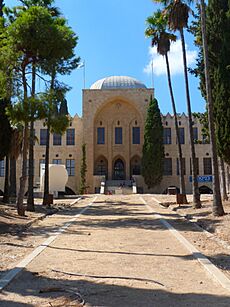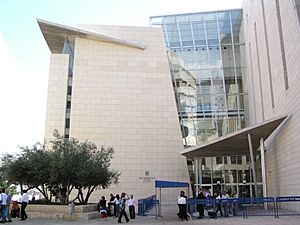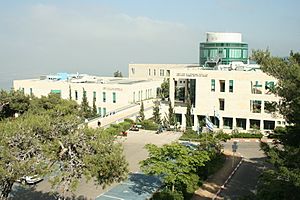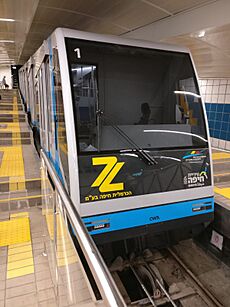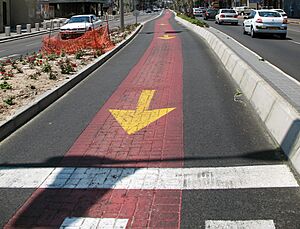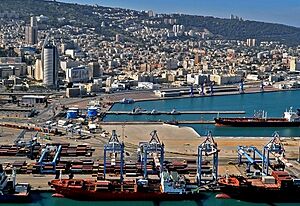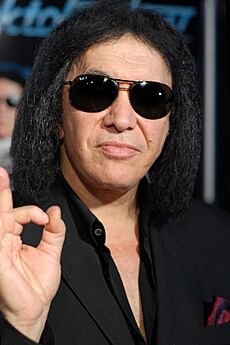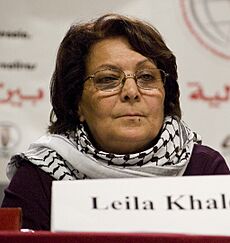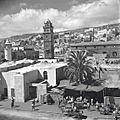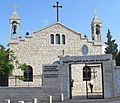Haifa facts for kids
Quick facts for kids
Haifa
|
|||
|---|---|---|---|
|
Skyline of Haifa from the Baháʼí World Centre
Sail Tower
Haifa Theatre
IEC Tower
Madatech
Bat Galim
Hadar HaCarmel
Stella Maris Monastery
|
|||
|
|||
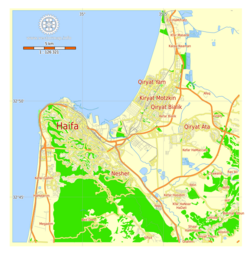
Map of Haifa
|
|||
| Country | |||
| District | Haifa | ||
| Subdistrict | Haifa | ||
| Founded | 1st century CE | ||
| Government | |||
| • Type | Mayor–council | ||
| • Body | Municipality of Haifa | ||
| Area | |||
| • City | 63,666 dunams (63.666 km2 or 24.582 sq mi) | ||
| Population
(2017)
|
|||
| • City | 281,087 | ||
| • Urban | 600,000 | ||
| • Metro | 1,050,000 | ||
| Demonym(s) | Haifan | ||
| Ethnicity | |||
| • Jews | 73.1% | ||
| • Arabs | 12.1% | ||
| • Others | 14.8% | ||
| Time zone | UTC+2 (IST) | ||
| • Summer (DST) | UTC+3 (IDT) | ||
Haifa is the third-largest city in Israel, after Jerusalem and Tel Aviv. It has a population of about 281,087 people. Haifa is part of a larger metropolitan area, which is the third most populated in Israel. It is famous for being home to the Baháʼí Faith's Baháʼí World Centre, which is a UNESCO World Heritage Site. Many people visit it for Baháʼí pilgrimage.
The city is built on the slopes of Mount Carmel and has a history stretching back over 3,000 years. The earliest known settlement nearby was Tell Abu Hawam, a small port city from the Late Bronze Age (around 14th century BCE). In the 3rd century CE, Haifa was known for making dyes. Over time, many different groups ruled the Haifa area, including the Canaanites, Israelites, Phoenicians, Assyrians, Babylonians, Persians, Romans, Byzantines, Arabs, Crusaders, Ottomans, and the British. After the 1948 Palestine war, Haifa became part of the new state of Israel.
Today, Haifa is a major seaport on Israel's Mediterranean coast, covering about 63.7 square kilometers (24.6 sq mi). It is about 90 kilometers (56 mi) north of Tel Aviv and is a key center for northern Israel. Haifa has two well-known universities: the University of Haifa and the Technion – Israel Institute of Technology. The Technion is one of the oldest and top-ranked universities in Israel and the Middle East. The city also has the largest K–12 school in Israel, the Hebrew Reali School. Haifa is important for Israel's economy. It hosts Matam, one of the oldest and largest high-tech parks in the country. Before the Tel Aviv Light Rail opened, Haifa was the only city in Israel with an underground rapid transit system called the Carmelit. Haifa Bay is also a hub for heavy industry, oil refining, and chemical processing. Haifa is known as one of Israel's mixed cities, where about 10% of the population are Arab-Israelis.
Contents
- What's in a Name? The Meaning of Haifa
- Haifa's Ancient Roots and Early Names
- A Look Back: Haifa's History
- Who Lives in Haifa?
- Haifa's Landscape and Climate
- Exploring Haifa's Neighborhoods
- Building the Future: Urban Development
- Haifa's Economy: A City That Works
- Arts and Culture in Haifa
- How Haifa is Governed
- Healthcare in Haifa
- Learning and Education in Haifa
- Getting Around: Transportation in Haifa
- Sports in Haifa
- Famous People from Haifa
- Sister Cities Around the World
- Images for kids
- See also
What's in a Name? The Meaning of Haifa
The exact meaning of the name Haifa is not fully clear. One idea is that it comes from the name of the high priest Caiaphas. Some Christians believe it was named after Saint Peter, whose Aramaic name was Keipha. Another idea is that it comes from the Hebrew word hafa, meaning "to cover or shield," suggesting Mount Carmel covers Haifa. Others think it might come from the Hebrew word hof, meaning "shore," or hof yafe, meaning "beautiful shore."
In the past, the city's name was spelled in different ways, like Caipha or Kaiffa.
Haifa's Ancient Roots and Early Names
The earliest known settlement in the Haifa area was called Sycaminum. Its ancient remains can be found at an archaeological mound called Tel Shikmona. The name Efa first appeared during Roman rule, when a Roman fort and a small Jewish settlement were built near Tel Shikmona. Haifa is also mentioned many times in the Talmud, an important Jewish text.
Around the 6th century, another place called Porphyreon was mentioned, located south of the older Haifa-Sycaminon area.
Early Muslim Haifa
After the Arab conquest in the 7th century, the name Haifa was used for a site built on the ruins of Sycaminon. Travelers like Nasir Khusraw (in 1047) noted that Haifa was a coastal city with many palm gardens and shipbuilders who made large boats.
Crusader and Ottoman Periods
When the Crusaders captured Haifa in the 12th century, they called it Caiphas. They thought the name was linked to Cephas, the Aramaic name for Simon Peter.
Later, in 1764–1765, Zahir al-Umar, a local Arab ruler, moved the village to a new, stronger location about 1.5 miles (2.4 km) to the east. This new village became the start of modern Haifa. It was first called "New Haifa" and then simply Haifa.
A Look Back: Haifa's History
Bronze Age and Biblical Times
A town known as Tell Abu Hawam was founded in the Late Bronze Age (14th century BCE). It was a port and fishing village. Mount Carmel and the Kishon River are mentioned in the Hebrew Bible. A cave on Mount Carmel is known as the "Cave of Elijah," linked to the Prophet Elijah.
From Persian Rule to the Byzantines
During the Persian period (6th century BCE), a Greek geographer wrote about a city near Mount Carmel, likely referring to Shikmona, an area in Haifa. By Hellenistic times, the city moved to a new spot because the old port was blocked by sand. Haifa was near Shikmona, a place known for making the Tekhelet dye used in special religious garments.
In the Roman period (around 3rd century CE), Haifa was a Jewish fishing village. Tombs from this era have been found. Under Byzantine rule, Haifa continued to grow but was not a major city.
Early Muslim Period and Crusader Rule
After the Arab conquest in the 630s–40s, Haifa began to develop. In the 9th century, it had trade links with Egyptian ports and shipyards. People, both Arabs and Jews, were involved in trade. Glassmaking and dye production were important industries.
This prosperity ended in 1100 or 1101 when European Christians, after the First Crusade, attacked and conquered Haifa. The city became a small fortified area under the Crusaders. In 1187, Saladin's army captured Haifa and destroyed its fortress. Richard the Lionheart later retook Haifa in 1191.
In the 12th century, religious hermits lived in Mount Carmel's caves. In the 13th century, they formed the Carmelites monastic order. Their church on Mount Carmel was later turned into a mosque, then a hospital. In the 19th century, it became the Stella Maris Monastery again.
In 1265, the Mamluk sultan Baibars captured Haifa, destroying its defenses to prevent Crusaders from returning. For a long time, Haifa was a small village or uninhabited.
Ottoman Period: Haifa's Rebirth
When the Ottoman Empire took over Palestine in 1516, Haifa was mostly empty. It slowly began to be resettled. In the 17th century, Haifa's port became busy again as more ships docked there.
In 1765, Zahir al-Umar moved the population to a new, stronger site to the east, which became modern Haifa. After his death in 1775, the city remained under Ottoman rule until 1918. In 1799, Napoleon Bonaparte briefly conquered Haifa but soon left.
Between 1831 and 1840, Egyptian rule helped Haifa grow. As the nearby city of Acre declined, Haifa's importance increased. By 1858, Haifa was growing outside its old city walls.
The arrival of German settlers called Templers in 1868 was a big moment for Haifa. They built a power station, factories, and carriage services, helping to modernize the city.
Jewish immigration to Haifa increased in the mid-19th century, especially from Morocco and Turkey. By the early 20th century, Haifa became an industrial port city. A railway was built, boosting trade. In 1912, construction began on the Technion Institute of Technology, a Jewish technical school that became a top university.
The Baháʼí Faith in Haifa
In 1909, Haifa became very important to the Baháʼí Faith. The remains of the Báb, a key figure in the Baháʼí Faith, were moved to Haifa and buried in a beautiful shrine on Mount Carmel. This shrine is considered their second holiest place on Earth.
British Mandate and Modern Development
British forces captured Haifa from the Ottomans in September 1918. Under British rule, Haifa grew into a major industrial port. Many Jewish immigrants settled in Haifa, and the port became a big source of income. The Arab population also grew with people moving from nearby villages.
The British developed the port and built oil refineries, making Haifa a center for heavy industries. Haifa was also one of the first cities to have full electricity. By 1945, Haifa's population was 138,300, with a mix of Jews, Muslims, and Christians.
Haifa in the State of Israel
After Israel was established in 1948, Haifa became a main entry point for Jewish immigrants. New neighborhoods were built for them. In 1959, some Sephardi and Mizrahi Jews protested in Wadi Salib, feeling they were not treated fairly.
While Tel Aviv grew, Haifa's role as a regional capital changed. However, Haifa's population reached 200,000 by the early 1970s, and many immigrants from the former Soviet Union boosted the population further. The Matam high-tech park, Israel's first dedicated high-tech park, opened in Haifa in the 1970s.
Haifa has faced challenges, including security incidents. In 2006, the city was hit by rockets during the Second Lebanon War, causing many people to leave temporarily.
Who Lives in Haifa?
Haifa is Israel's third-largest city. About 25% of its population are immigrants from the former Soviet Union, making Russian one of the main languages spoken.
Israeli Arabs make up about 10% of Haifa's population. Many live in neighborhoods like Wadi Nisnas, Abbas, and Khalisa. Wadi Nisnas and Abbas are mostly Christian, while Khalisa and Kababir are mostly Muslim. Haifa is often seen as a place where Arabs and Jews live together peacefully, though some tensions can still exist.
The city's population is diverse. About 82% are Israeli Jews, almost 14% are Christians (mostly Arab Christians), and about 4% are Muslims. Haifa also has Druze and Baháʼí Faith communities. Christian Arabs in Haifa tend to be well-educated and successful. The Melkite Greek Catholic Archeparchy of Akka is based in Haifa, with its main church being St. Elijah Greek-Melkite Cathedral.
Haifa is a center for liberal Arabic-speaking culture. Its Arabic-speaking neighborhoods have a lively cultural scene with theaters, cafes, and nightclubs.
Haifa's Landscape and Climate
Haifa is located on Israel's Mediterranean Coastal Plain, a historic land bridge between continents. It sits on the northern slopes of Mount Carmel and around Haifa Bay. The city is built on three levels: the lowest part is for business and industry, the middle level has older homes on the slopes, and the upper level has modern neighborhoods with great views. From here, you can see across the Western Galilee region towards the Lebanese border. Haifa is known for its many beaches along the Mediterranean.
Wildlife in Haifa
Mount Carmel has three main valleys: Lotem, Amik, and Si'ach. These valleys are mostly natural areas that run through the city from the coast to the top of the mountain. They have hiking paths and are home to animals like wild boar, golden jackal, hyrax, Egyptian mongoose, owls, and chameleons.
Wild boars have become common in Haifa, coming down from the valleys into the city streets.
Haifa's Weather Patterns
Haifa has a hot-summer Mediterranean climate. This means it has hot, dry summers and mild, rainy winters. Spring starts in March, and by late May, it's warm for summer. The average summer temperature is about 26°C (79°F), and in winter, it's about 12°C (54°F). Frost is rare, and snow almost never falls, with the last time being in 1950. It's usually humid all year, and most rain falls between September and May. The city gets about 629 millimeters (24.8 inches) of rain each year.
| Climate data for Haifa Airport (5 m / 16 ft) (Temperature: 1995–2010, Extremes 1898–2011, Precipitation: 1980–2010) | |||||||||||||
|---|---|---|---|---|---|---|---|---|---|---|---|---|---|
| Month | Jan | Feb | Mar | Apr | May | Jun | Jul | Aug | Sep | Oct | Nov | Dec | Year |
| Record high °C (°F) | 27.0 (80.6) |
30.4 (86.7) |
38.0 (100.4) |
42.5 (108.5) |
44.6 (112.3) |
43.5 (110.3) |
37.8 (100.0) |
37.8 (100.0) |
41.8 (107.2) |
41.4 (106.5) |
36.0 (96.8) |
31.5 (88.7) |
44.6 (112.3) |
| Mean maximum °C (°F) | 22.6 (72.7) |
25.0 (77.0) |
29.9 (85.8) |
35.5 (95.9) |
36.2 (97.2) |
34.6 (94.3) |
35.2 (95.4) |
34.1 (93.4) |
34.7 (94.5) |
35.4 (95.7) |
30.3 (86.5) |
24.7 (76.5) |
36.2 (97.2) |
| Mean daily maximum °C (°F) | 17.8 (64.0) |
18.6 (65.5) |
20.9 (69.6) |
23.8 (74.8) |
26.5 (79.7) |
29.5 (85.1) |
31.6 (88.9) |
31.6 (88.9) |
30.2 (86.4) |
27.9 (82.2) |
24.4 (75.9) |
19.8 (67.6) |
25.2 (77.4) |
| Daily mean °C (°F) | 13.9 (57.0) |
14.4 (57.9) |
16.5 (61.7) |
19.4 (66.9) |
22.4 (72.3) |
25.7 (78.3) |
28.0 (82.4) |
28.4 (83.1) |
26.7 (80.1) |
23.7 (74.7) |
19.8 (67.6) |
15.8 (60.4) |
21.2 (70.2) |
| Mean daily minimum °C (°F) | 10.0 (50.0) |
10.2 (50.4) |
12.1 (53.8) |
14.8 (58.6) |
18.2 (64.8) |
21.9 (71.4) |
24.4 (75.9) |
25.1 (77.2) |
23.2 (73.8) |
19.5 (67.1) |
15.1 (59.2) |
11.8 (53.2) |
15.9 (60.6) |
| Mean minimum °C (°F) | 5.4 (41.7) |
6.1 (43.0) |
7.6 (45.7) |
9.5 (49.1) |
13.7 (56.7) |
18.4 (65.1) |
21.7 (71.1) |
22.7 (72.9) |
19.5 (67.1) |
14.8 (58.6) |
9.9 (49.8) |
7.3 (45.1) |
5.4 (41.7) |
| Record low °C (°F) | −1.6 (29.1) |
−3.5 (25.7) |
2.0 (35.6) |
4.3 (39.7) |
9.6 (49.3) |
13.0 (55.4) |
17.0 (62.6) |
17.9 (64.2) |
14.2 (57.6) |
8.5 (47.3) |
5.0 (41.0) |
0.2 (32.4) |
−3.5 (25.7) |
| Average rainfall mm (inches) | 124.9 (4.92) |
95.2 (3.75) |
52.8 (2.08) |
23.6 (0.93) |
2.7 (0.11) |
0.1 (0.00) |
0.0 (0.0) |
0.0 (0.0) |
1.2 (0.05) |
28.0 (1.10) |
77.8 (3.06) |
135.5 (5.33) |
541.8 (21.33) |
| Average rainy days (≥ 0.1 mm) | 13.9 | 11.7 | 8.6 | 3.6 | 1.4 | 0.1 | 0.1 | 0 | 0.8 | 3.9 | 8.0 | 11.8 | 63.9 |
| Source: Israel Meteorological Service | |||||||||||||
| Climate data for University of Haifa (475 m / 1558 ft) (Temperature: 1995–2010, Precipitation: 1980–2010) | |||||||||||||
|---|---|---|---|---|---|---|---|---|---|---|---|---|---|
| Month | Jan | Feb | Mar | Apr | May | Jun | Jul | Aug | Sep | Oct | Nov | Dec | Year |
| Record high °C (°F) | 23.6 (74.5) |
26.2 (79.2) |
32.9 (91.2) |
36.6 (97.9) |
39.0 (102.2) |
38.9 (102.0) |
36.6 (97.9) |
34.9 (94.8) |
38.9 (102.0) |
36.3 (97.3) |
30.0 (86.0) |
28.3 (82.9) |
39.0 (102.2) |
| Mean daily maximum °C (°F) | 13.3 (55.9) |
14.2 (57.6) |
16.8 (62.2) |
20.2 (68.4) |
23.3 (73.9) |
25.1 (77.2) |
26.5 (79.7) |
26.9 (80.4) |
26.2 (79.2) |
24.2 (75.6) |
19.9 (67.8) |
15.5 (59.9) |
21.0 (69.8) |
| Daily mean °C (°F) | 11.0 (51.8) |
11.5 (52.7) |
13.8 (56.8) |
16.5 (61.7) |
19.7 (67.5) |
22.0 (71.6) |
23.7 (74.7) |
24.2 (75.6) |
23.4 (74.1) |
21.3 (70.3) |
17.2 (63.0) |
13.1 (55.6) |
18.1 (64.6) |
| Mean daily minimum °C (°F) | 8.6 (47.5) |
8.9 (48.0) |
10.7 (51.3) |
12.9 (55.2) |
16.1 (61.0) |
18.8 (65.8) |
20.8 (69.4) |
21.5 (70.7) |
20.6 (69.1) |
18.4 (65.1) |
14.6 (58.3) |
10.7 (51.3) |
15.2 (59.4) |
| Record low °C (°F) | −0.3 (31.5) |
1.3 (34.3) |
1.0 (33.8) |
4.2 (39.6) |
10.1 (50.2) |
11.5 (52.7) |
16.7 (62.1) |
18.1 (64.6) |
15.9 (60.6) |
8.8 (47.8) |
5.1 (41.2) |
2.5 (36.5) |
−0.3 (31.5) |
| Average rainfall mm (inches) | 166 (6.5) |
128 (5.0) |
71 (2.8) |
21 (0.8) |
5 (0.2) |
0 (0) |
0 (0) |
0 (0) |
2 (0.1) |
36 (1.4) |
93 (3.7) |
161 (6.3) |
683 (26.8) |
| Average rainy days (≥ 0.1 mm) | 14 | 12 | 9 | 4 | 1 | 0 | 0 | 0 | 1 | 4 | 8 | 12 | 65 |
| Average relative humidity (%) | 68 | 67 | 63 | 61 | 63 | 74 | 80 | 82 | 74 | 67 | 59 | 65 | 69 |
| Source: Israel Meteorological Service | |||||||||||||
Exploring Haifa's Neighborhoods
Haifa's neighborhoods are built on different levels of Mount Carmel. The oldest part of modern Haifa is Wadi Salib, near the port. The German Colony, built in the 19th century, was the first planned neighborhood and is now a lively area.
Hadar, built in the early 20th century, was once Haifa's main cultural and shopping area. It stretches from the port up Mount Carmel. Above Hadar are wealthier neighborhoods like Carmel Tzarfati (French Carmel) and Merkaz HaCarmel (Carmel Center). While there are separate Arab and Jewish neighborhoods, more wealthy Arabs are choosing to live in Jewish areas. Kababir, home to the National Headquarters of Israel's Ahmadiyya Community, is another Carmel neighborhood.
Building the Future: Urban Development
Haifa is always growing and changing. New homes are being built, especially in areas like Kiryat Haim and Kiryat Shmuel. The city is also developing its downtown area, including Wadi Salib, where historic buildings are being renovated into places like nightclubs and theaters.
A big plan for Haifa's waterfront was announced. The western part of the port will be turned into a tourism and nightlife area. All port activities will move to the east. A beach promenade and public spaces are being built. The train tracks that separate the beach from the city will be buried underground. A park will be created along the Kishon River.
Another plan aims to make Haifa the main tourist center for Northern Israel. This includes building more hotels and improving connections to nearby cities like Acre and Nazareth. A new life sciences park is also being built next to the Matam high-tech park.
Haifa's Economy: A City That Works
There's a saying in Israel: "Haifa works, Jerusalem prays, and Tel Aviv plays." This shows Haifa's reputation as a city of industry and hard work. The industrial area is in the eastern part of the city, near the Kishon River. It has the Haifa oil refinery, one of two in Israel.
Matam (short for Scientific Industries Center) is Israel's largest and oldest business park. It's located at the southern entrance to the city. Many big Israeli and international hi-tech companies, like Apple, Amazon, Intel, IBM, and Microsoft, have offices and research facilities there. The University of Haifa also hosts IBM Haifa Labs.
The Port of Haifa is very important for cargo and passengers in Israel. Haifa also has many shopping malls. In 2010, Monocle magazine even called Haifa the city with the most promising business potential in the world. The city is working to attract more businesses and tourists.
Tourism in Haifa
Haifa has a 17-kilometer (11 mi) coastline, with 5 kilometers (3.1 mi) of beaches. The main tourist attraction is the Baháʼí World Centre, with its golden-domed Shrine of the Báb and beautiful gardens. These gardens became a UNESCO World Heritage Site in 2008. Other popular spots include the restored German Colony, Stella Maris Monastery, and Elijah's Cave.
Near Haifa, you can visit the Ein Hod artists' colony, where many artists have studios. There's also the Mount Carmel national park, which has caves where ancient human remains were found.
Arts and Culture in Haifa
Haifa is a cultural center for northern Israel. The Haifa Theatre was the first city-funded theater in the country. Other theaters include the al-Midan Theater for Arabic plays and the Krieger Centre for the Performing Arts. The Congress Center hosts many events.
The New Haifa Symphony Orchestra, started in 1950, has many fans. The Haifa Cinematheque hosts the yearly Haifa International Film Festival. Haifa also has many movie theaters and its own radio station, Radio Haifa.
Haifa's Museums
Haifa has over a dozen museums. The most popular is the Israel National Museum of Science, Technology, and Space, located in the old Technion building. The Haifa Museum of Art shows modern and classical art, plus Haifa's history. The Tikotin Museum of Japanese Art is the only museum in the Middle East focused only on Japanese art.
Other museums include the Museum of Prehistory, the National Maritime Museum, the Hecht Museum, and the Clandestine Immigration and Naval Museum. The former homes of artists Mane-Katz and Hermann Struck are now museums. The Haifa Educational Zoo has a small animal collection.
How Haifa is Governed
Haifa has traditionally been a strong area for the Labor party, partly because of its many dock workers and trade unions. Before 1948, Haifa's city government was unique because it had both Arab and Jewish representatives working together.
Today, Haifa is led by its city council and the mayor, Einat Kalisch-Rotem. The city council makes local laws and has 31 members. Many decisions come from committees where city council members and others meet.
Mayors of Haifa
- Najib Effendi al-Yasin (1873–77)
- Ahmad Effendi Jalabi (1878–81)
- Mustafa Bey al-Salih (1881–84)
- Mustafa Pasha al-Khalil (1885–1903)
- Jamil Sadiq (1904–10)
- Rif'at al-Salah (1910–11)
- Ibrahim al-Khalil (1911–13)
- Abd al-Rahman al-Haj (1920–27)
- Hassan Bey Shukri (1914–20, 1927–40)
- Shabtai Levy (1940–51)
- Abba Hushi (1951–1969)
- Moshe Flimann (1969–1973)
- Yosef Almogi (1974–1975)
- Yeruham Zeisel (1975–1978)
- Arie Gur'el (1978–1993)
- Amram Mitzna (1993–2003)
- Giora Fisher (interim mayor, 2003)
- Yona Yahav (2003–2018)
- Einat Kalisch-Rotem (2018–present)
Healthcare in Haifa
Haifa has many hospitals, with a total of 4,000 hospital beds. The largest is the Rambam Hospital, which has 900 beds. Other hospitals include Bnai Zion Medical Center and Carmel Hospital. Haifa also has 20 family health centers. During the 2006 Lebanon War, Rambam Medical Center had to move parts of the hospital to underground shelters to protect patients.
Learning and Education in Haifa

Haifa is home to two well-known universities and several colleges. The University of Haifa, founded in 1963, is on top of Mount Carmel. The Technion – Israel Institute of Technology, founded in 1912, was the first higher education school to teach in Hebrew. It has many different departments and research centers. The original Technion building now houses the Israel National Museum of Science, Technology, and Space.
The Hebrew Reali School, founded in 1913, is the largest K-12 school in Israel, with 4,000 students across seven branches. Other schools include the Gordon College of Education and the WIZO Haifa Academy of Design and Education. The University of Haifa has the largest percentage of Arab-Israeli students among Israeli universities.
In 2006–07, Haifa had many schools, from kindergartens to high schools. Most students attended Hebrew-speaking schools, but 14% attended Arab schools. Two respected Arab schools in Haifa are the Orthodox School and the Nazareth Nuns' School, both run by Christian churches. About 70% of Arab students in Haifa attend Christian schools.
Getting Around: Transportation in Haifa
Public Transport Options
Haifa has six railway stations and the Carmelit, which is Israel's only subway system. The main railway line runs along the coast, connecting Haifa to Tel Aviv, Ben Gurion International Airport, and other cities.
Egged bus company operates most of Haifa's intercity buses from two main terminals: HaMifratz Central Bus Station and Haifa Hof HaCarmel Central Bus Station. Buses from HaMifratz go north, and buses from Hof HaCarmel go south.
All city bus lines are also run by Egged. Haifa also has a new bus rapid transit system called the Metronit. These special buses run on dedicated lanes, offering a tram-like service. The Metronit system opened in August 2013.
Haifa is one of the few cities in Israel where buses run on Shabbat (the Sabbath), though on a reduced schedule. Night buses also operate seven nights a week, making Haifa unique in Israel for its 24/7 public transportation.
The Carmelit subway is an underground funicular railway that goes from downtown Paris Square up to Gan HaEm (Mother's Park) on Mount Carmel. It's known as the world's shortest metro line.
Haifa also has two cable cars. The Bat Galim cable car connects the coast to the Stella Maris monastery on Mount Carmel, mainly for tourists. A second cable car, Rakavlit, opened in April 2022. It's a 4.4-kilometer (2.7 mi) commuter cable car that runs from HaMifratz Central Bus Station to the Technion and then to the University of Haifa.
Air and Sea Travel
Haifa Airport serves international flights to Cyprus. Before the COVID-19 pandemic, it also had flights to Egypt, Greece, Jordan, and Turkey, as well as domestic flights within Israel. There are plans to expand services from Haifa Airport.
airHaifa is a new airline that started operations in September 2024, offering flights from Haifa to Eilat and later to Cyprus, Greece, and Turkey.
Road Connections
You can travel between Haifa and central Israel using Highway 2, a major highway along the coast. Highway 4 also runs along the coast north and south of Haifa. The Carmel Tunnels, opened in December 2010, help traffic flow under Mount Carmel, reducing congestion in the city center.
Sports in Haifa
Haifa has a modern stadium called Sammy Ofer Stadium, which seats over 30,000 people. It was finished in 2014. The city's two main football clubs are Maccabi Haifa and Hapoel Haifa. Both play in Israel's top league and share the Sammy Ofer Stadium. Maccabi Haifa has won many Israeli titles.
Haifa also has professional basketball clubs, Hapoel Haifa and Maccabi Haifa, which play in the top division at the Romema Arena. The city also has an American football club, the Haifa Underdogs, and an ice hockey team, the Haifa Hawks. In 1996, Haifa hosted the World Windsurfing Championship. The Haifa Tennis Club is one of the largest in Israel.
Famous People from Haifa
Many notable people come from Haifa, including:
- Abed Abdi (born 1942), a painter and sculptor.
- Ralph Bakshi (born 1938), an animator and filmmaker.
- Naftali Bennett (born 1972), a politician.
- Aaron Ciechanover (born 1947), a biologist and Nobel Prize winner in Chemistry.
- Jonathan Erlich (born 1977), a tennis player.
- Ari Folman (born 1962), a filmmaker.
- Gene Simmons (born 1949), a musician.
- Odeya Rush (born 1997), a Hollywood actress and model.
- Lior Suchard (born 1981), a mentalist.
- Avi Wigderson (born 1956), a mathematician and computer scientist who won the Abel Prize.
Sister Cities Around the World
Haifa is twinned with many cities across the globe, helping to build friendships and cultural exchange:
 Marseille, France (1962)
Marseille, France (1962) Portsmouth, United Kingdom (1962)
Portsmouth, United Kingdom (1962) Hackney, United Kingdom (1968)
Hackney, United Kingdom (1968) Manila, Philippines (1971)
Manila, Philippines (1971) San Francisco, United States (1973)
San Francisco, United States (1973) Aalborg, Denmark (1973)
Aalborg, Denmark (1973) Cape Town, South Africa (1975)
Cape Town, South Africa (1975) Bremen, Germany (1978)
Bremen, Germany (1978) Newcastle upon Tyne, United Kingdom (1979)
Newcastle upon Tyne, United Kingdom (1979) Antwerp, Belgium (1986)
Antwerp, Belgium (1986) Mainz, Germany (1987)
Mainz, Germany (1987) Düsseldorf, Germany (1988)
Düsseldorf, Germany (1988) Rosario, Argentina (1988)
Rosario, Argentina (1988) Odesa, Ukraine (1992)
Odesa, Ukraine (1992) Shanghai, China (1994)
Shanghai, China (1994) Limassol, Cyprus (2000)
Limassol, Cyprus (2000) Fort Lauderdale, United States (2002)
Fort Lauderdale, United States (2002) Erfurt, Germany (2005)
Erfurt, Germany (2005) Mannheim, Germany (2005)
Mannheim, Germany (2005) Shenzhen, China (2012)
Shenzhen, China (2012) Chengdu, China (2013)
Chengdu, China (2013) Shantou, China (2015)
Shantou, China (2015)
Images for kids
See also
 In Spanish: Haifa para niños
In Spanish: Haifa para niños




